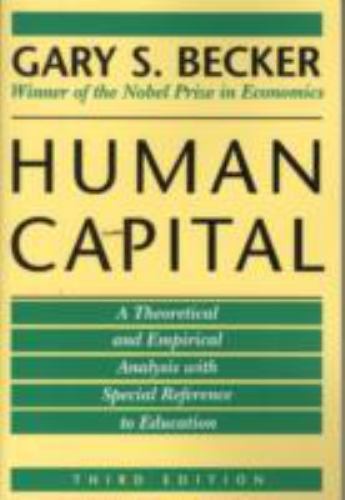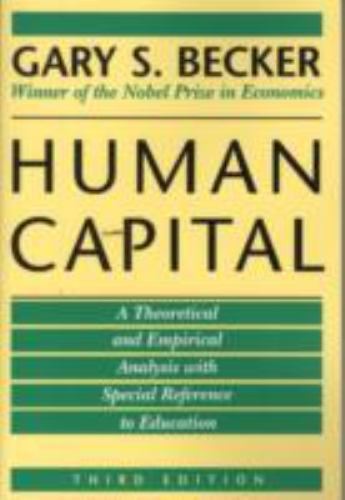Picture 1 of 1

Stock photo

Picture 1 of 1

Stock photo

Human Capital : A Theoretical and Empirical Analysis, with Special Reference to Education, 3rd Edition by Gary S. Becker (1994, Trade Paperback)

rudiander72 (855)
99.4% positive feedback
Price:
$10.00
+ $5.22 shipping
Returns:
Condition:
Oops! Looks like we're having trouble connecting to our server.
Refresh your browser window to try again.
About this product
Product Identifiers
PublisherUniversity of Chicago Press
ISBN-100226041204
ISBN-139780226041209
eBay Product ID (ePID)80749
Product Key Features
Number of Pages412 Pages
LanguageEnglish
Publication NameHuman Capital : A Theoretical and Empirical Analysis, with Special Reference to Education, 3rd Edition
Publication Year1994
SubjectHuman Resources & Personnel Management, General, Economics / General, Labor
TypeTextbook
AuthorGary S. Becker
Subject AreaEducation, Business & Economics
FormatTrade Paperback
Dimensions
Item Height1 in
Item Weight20 Oz
Item Length9 in
Item Width6 in
Additional Product Features
Edition Number3
Intended AudienceScholarly & Professional
LCCN93-024690
IllustratedYes
Table Of ContentList of Tables List of Charts Preface to the Third Edition Preface to the First Edition I. Introduction to the Second Edition Introduction to the First Edition II. Human Capital Revisited 1. Introduction 2. Education and Training 3. Human Capital and the Family 4. Human Capital and Economic Development 5. Conclusions 6. References Part One: Theoretical Analysis III. Investment in Human Capital: Effects on Earnings 1. On-the-Job Training General Training Specific Training 2. Schooling 3. Other Knowledge 4. Productive Wages Increases IV. Investment in Human Capital: Rates of Return 1. Relation between Earnings, Costs, and Rates of Return Addendum: The Allocation of Time and Goods over Time 2. The Incentive to Invest Number of Periods Wage Differentials and Secular Changes Risk and Liquidity Capital Markets and Knowledge 3. Some Effects of Human Capital Examples Ability and the Distribution of Earnings Addendum: Education and the Distribution of Earnings: A Statistical Formulation Addendum: Human Capital and the Personal Distribution of Income: An Analytical Approach Supplement: Estimating the Effect of Family Backgrounds on Earnings Part Two: Empirical Analysis V. Rates of Return from College Education 1. Money Rates of Return to White Male College Graduates Returns in 1939 Costs in 1939 Rates of Return in 1939 Rates of Return in 1949 2. Some Conceptual Difficulties Correlation between "Ability" and Education Correlation between Education and Other Human Capital 3. Rates of Return to Other College Persons College Dropouts Nonwhites Women Rural Persons 4. Variation in Rates of Return VI. Underinvestment in College Education? 1. Private Money Gains 2. Social Productivity Gains 3. Private Real Rates VII. Rates of Return from High School Education and Trends over Time 1. The Rate of Return from High School Education 2. Trends in Rates of Return After 1939 Before 1939 VIII. Age, Earnings, Wealth, and Human Capital 1. Age-Earnings Profiles 2. Age-Wealth Profiles IX. Summary and Conclusions 1. Summary 2. Future Research 3. Concluding Comments Part Three: Economy-Wide Changes Introduction X. Human Capital and the Rise and Fall of Families, by Gary S. Becker and Nigel Tomes 1. Introduction 2. Earnings and Human Capital Perfect Capital Markets Imperfect Access to Capital 3. Assets and Consumption 4. Fertility and Marriage 5. Empirical Studies 6. Summary and Discussion References XI. The Division of Labor, Coordination Costs, and Knowledge, by Gary S. Becker and Kevin M. Murphy 1. Introduction 2. Division of Labor among Tasks 3. Coordination Costs 4. Knowledge and Specialization 5. Extent of the Market 6. The Growth in Specialization and Knowledge 7. The Division of Labor between Sectors: Teachers and Workers 8. Summary Appendix References XII. Human Capital, Fertility, and Economic Growth, by Gary S. Becker, Kevin M. Murphy, and Robert Tamura 1. Introduction 2. Basic Properties of the Model 3. Fertility and Growth 4. Comparative Advantage in the Production of Human Capital 5. Discussion 6. Concluding Remarks References Appendixes A. Sources and Methods 1. Incomes a. The Basic Data b. Under- and Overreporting c. Unemployment d. Coverage in 1939 e. Taxes f. Urban-Rural Distribution g. Hours of Work 2. Costs a. Earnings of Students b. Direct Private Costs c. Direct Social Costs B. Mathematical Discussion of Relation between Age, Earnings, and Wealth Author Index Subject Index
SynopsisHuman Capital is Becker's classic study of how investment in an individual's education and training is similar to business investments in equipment. Recipient of the 1992 Nobel Prize in Economic Science, Gary S. Becker is a pioneer of applying economic analysis to human behavior in such areas as discrimination, marriage, family relations, and education. Becker's research on human capital was considered by the Nobel committee to be his most noteworthy contribution to economics. This expanded edition includes four new chapters, covering recent ideas about human capital, fertility and economic growth, the division of labor, economic considerations within the family, and inequality in earnings. "Critics have charged that Mr. Becker's style of thinking reduces humans to economic entities. Nothing could be further from the truth. Mr. Becker gives people credit for having the power to reason and seek out their own best destiny."- Wall Street Journal, Human Capital is Becker's classic study of how investment in an individual's education and training is similar to business investments in equipment. Recipient of the 1992 Nobel Prize in Economic Science, Gary S. Becker is a pioneer of applying economic analysis to human behavior in such areas as discrimination, marriage, family relations, and education. Becker's research on human capital was considered by the Nobel committee to be his most noteworthy contribution to economics. This expanded edition includes four new chapters, covering recent ideas about human capital, fertility and economic growth, the division of labor, economic considerations within the family, and inequality in earnings. "Critics have charged that Mr. Becker's style of thinking reduces humans to economic entities. Nothing could be further from the truth. Mr. Becker gives people credit for having the power to reason and seek out their own best destiny."-- Wall Street Journal
All listings for this product
Be the first to write a review
































